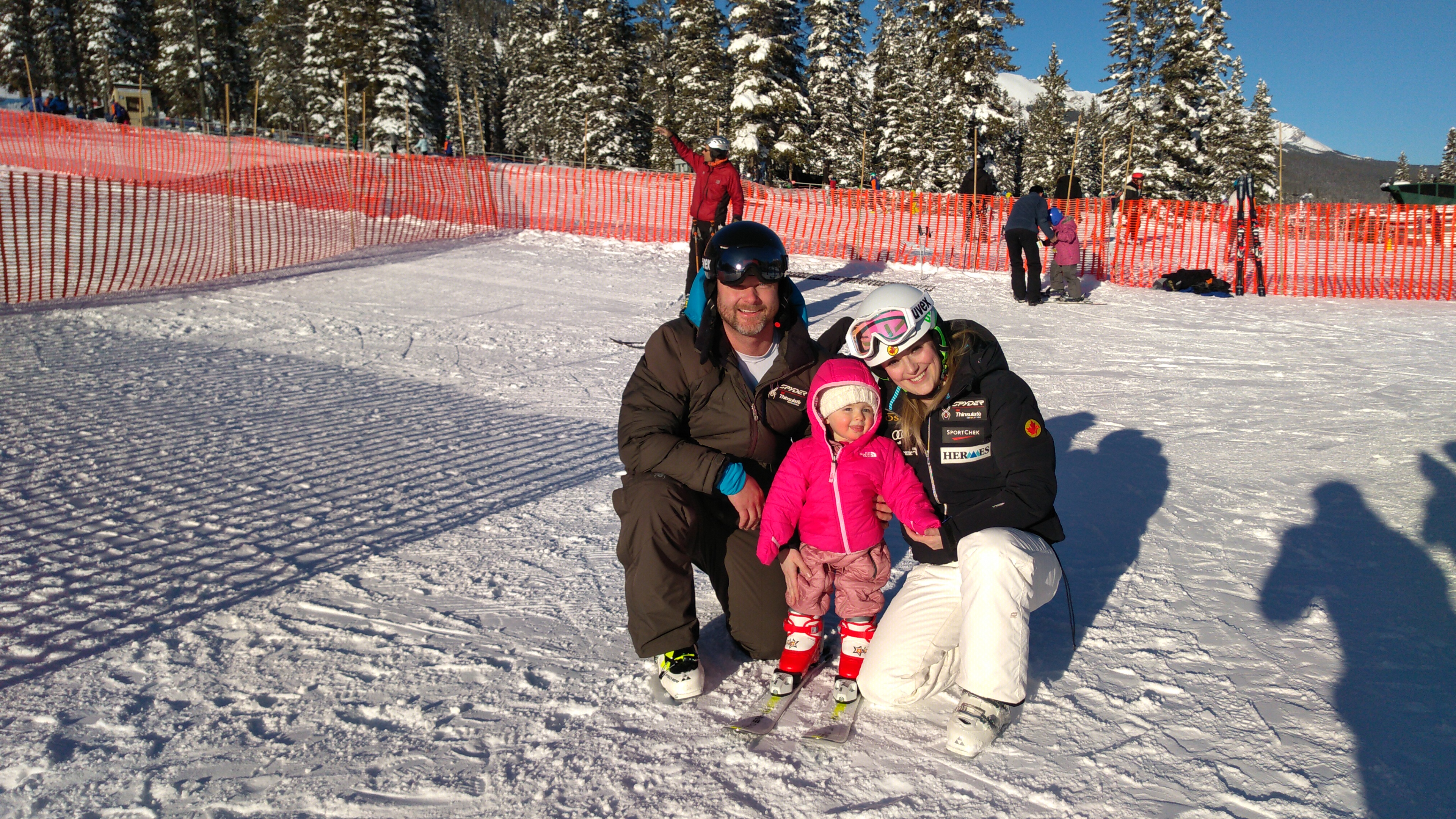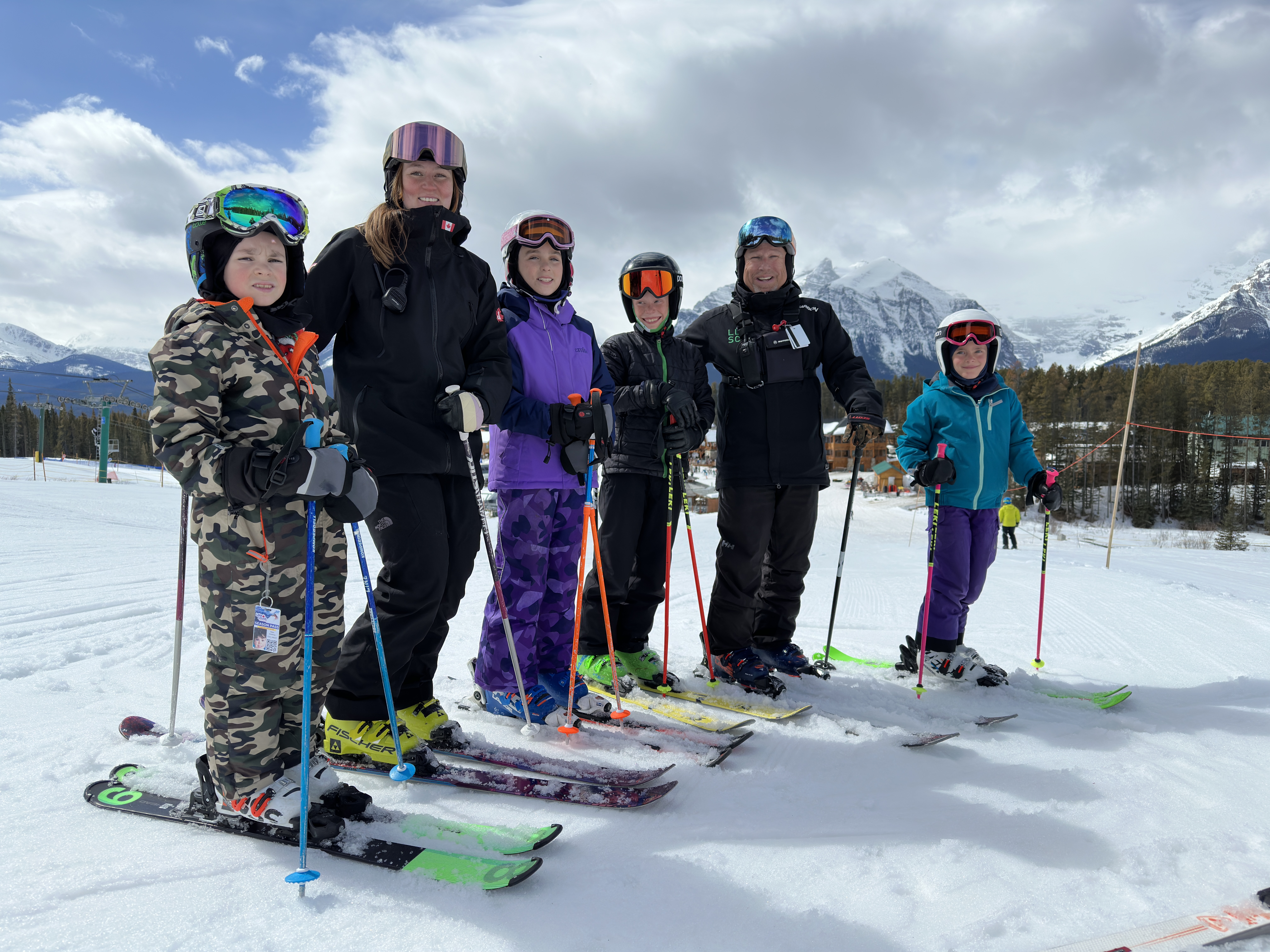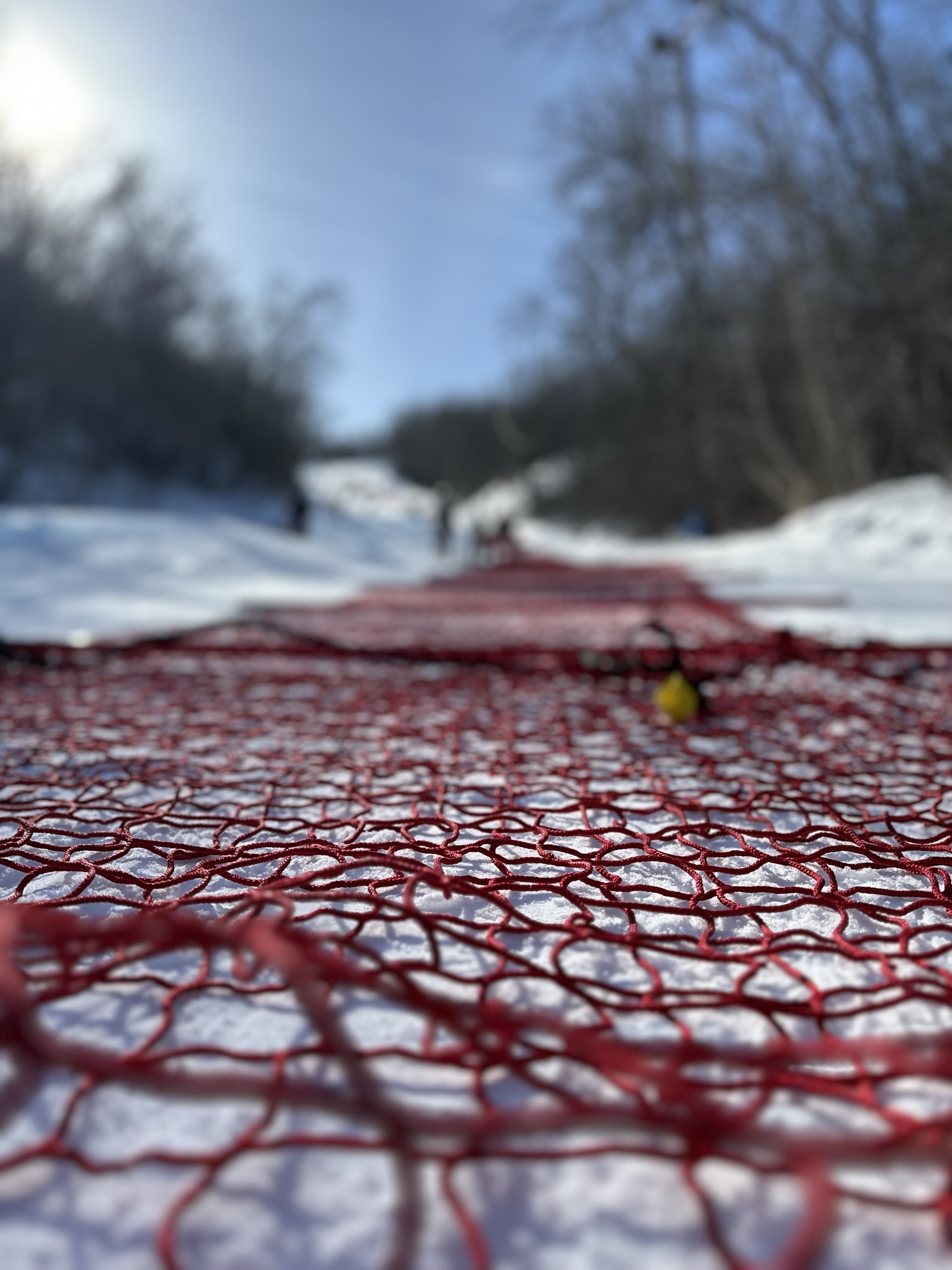Gliding Start
IGNITE THE SPARK
The primary goal of this stage is to introduce children to skiing in a positive manner. This stage is all about making physical activity a fun part of daily life by creating the right setting for your child to learn.
Photo: Alpine Canada National Team Alumni Paul Stutz and Family were celebrating one of Stella's first days on snow.
KEY CONCEPTS
Parents, ski schools and ski clubs play a great role in the introduction of children to skiing. Skiing should be a playful activity for every child at this stage.
The goal is to maximize the number of days and time on skis while fostering the love of skiing. Skiing with a formal ski lesson with an instructor and should last between one and three hours depending on the level and experience of the skier.
Providing positive feedback and ongoing encouragement as often as possible will increase the experience for every child.
- Keep children active, they should not be sedentary for more than sixty minutes at a time unless they are sleeping.
- Help them learn fundamental movement skills. Recognize that these skills develop over time, and it's not easy, but there are guides and resources available.
- Encourage your child to participate in complementary sports which will benefit their long-term development
- Let children explore their physical environment while keeping a watchful eye on them to ensure they are safe.
- Be a positive role model.
- Show respect to coaches, officials and volunteers while demonstrating good sportsmanship, respect and integrity.
Positive feedback and ongoing encouragement from parents and coaches have been proven to increase the likelihood of:
- Ongoing participation
- Increased success
- Improved self-esteem
LTAD PARENT TIPS
|
General |
The Sport for Life website provides an excellent overview of the various stages of development encompassing all aspect of an athletes development. |
|---|---|
|
Coaching |
Hire only trained and certified coaches or ski instructors who follow the ACA LTAD guidelines. |
|
Equipment |
Ensure your child has appropriate equipment including skis, boots and warm winter clothing. |
|
Training & Competition Volumes |
Time on snow is a precious commodity during the winter months. Children should aim to complete more than the minimum number of suggested days on snow because time and mileage on snow in the early years is more difficult to replace in the later stages of development. |
|
Family |
Spend time skiing with your children after their ski lessons/club training whenever possible. Skiing with your child will only increase their volume, but it will also promote a love for skiing. Children learn by watching; it is suggested that parents become involved with their local ski club and ski school by enrolling in clinics or lessons to refine their skiing skills to ensure they are providing a good visual example for their children. |
|
Building Athletic Character |
While children are young at this stage, encouraging your child to be positive, appreciate their coaches and teammates, and love skiing will ensure your child is off to a great start. |
|
Mental Development |
Provide ongoing encouragement, and positive feedback will promote a love for skiing and activity in general. Young children will progress at different rates - be patient. |
|
Physical Literacy |
The most important step toward developing physical literacy, is the mastering of fundamental movement skills including running, skating, sliding, throwing, balancing, and stopping. Participating in a variety of sports or activities will enhance your child's ability to ski fast. |
|
Choosing a Club |
One of the most important decisions you will make during the early stages of your child's' development will be determining which club to join. |
|
Health and Wellness |
Ensure young children are maintaining their health and wellness in the areas of sleep, nutrition, hydration, time on task, etc.. Maintain a good balance between sport, family, education and social activities. The time spent travelling to/from the ski hill and at the ski hill can be long. Consider bringing snacks, water, etc. to ensure your child is properly fueled. |
CHOOSING A CLUB
Choosing a club that fits your family is one of the most critical decisions. Here are some sample questions to use when researching the best organization for you and your child.
- Are the coaches certified in the National Coaching Certification Program?
- What coaching experience do they have and at what levels?
- Do they have healthy short and long-term goals?
- Has the club taken the Responsible Coaching Movement pledge?
- Do they have secure 'Safe in Sports Policies'?
- Do they follow the ACA LTAD guidelines?
- Does the program emphasize the proper development of fundamental movement and skiing skills?
- What is the driving time to the hill (proximity)?
- What is the overall reputation of the club for providing a quality sports environment for athletes at the Gliding Start stage?
- What is the club reputation amongst parents of current athletes?
- How many days on snow (volume) is available to your child and is it consistent with the ACA LTAD recommendations?
- What is the cost? Volunteer expectations?
- Is there an equipment pool available?
- Are they committed to creating efficiencies for the parents?
EQUIPMENT
Poorly fitting, improperly adjusted or un-tuned equipment can prevent a child from successfully developing their fundamental skiing skills.
The proper equipment set up and fit can help provide the young skier with a positive sports experience that gives the skier increased chances of having success with developing their fundamental skiing skills. Poorly fitting, improperly adjusted or un-tuned equipment can prevent a skier from successfully developing their fundamental skiing skills.
For more information regarding equipment selection for your child, please work in partnership with your local club coach to ensure your skier has the best equipment set up to promote proper skill development and execution.
Alpine Canada Partners and Equipment Pool Suppliers
To review equipment requirements for the Gliding Start stage, visit the equipment category on the Gliding Start stage.
MAINTAINING BALANCE
Raising active children in today's busy world can be challenging. Family time and being engaged with your children at this stage assists with creating the habit of being physically active for life.
Maintaining a balanced family life that fosters the development of healthy habits includes:
- Scheduling family time and activities where the family can be active together. Skiing is a great family activity.
- Making sure everyone in the family has time for rest and regeneration.
- Finding a balance between sports and encouraging multi-sport exposure.
- Allowing for social "play" time with other children in a supervised but unstructured environment like the park playground.
- When children begin school, monitor the child’s response to ensure a right balance is maintained between physical activity and regeneration of mind and body.
- Use the PLAYinventory form found underneath physcial literacy page to record and track a child’s leisure-time activities throughout the year.
- Parents becoming involved through volunteer activities, when children begin to participate in a more structured sports program, at the child’s local club.
REFERENCES:
ACA LTAD Gliding Start Key Concepts
ACA LTAD Gliding Start Webinar
Sport for Life - Long Term Development in Sport & Physical Activity 3.0. Higgs, Colin & Way, Richard & Harber, Vicki, Jurbala, Paul, Bayli, Istvan. (2019). Long-Term Development in Sport and Physical Activity 3.0. Canadian Sport for Life. ISBN: 978-1-927921-62-3.
Canadian Sport for Life Article: Maximizing the Sport Experience for our Children by Dina Bell-Laroche
ACA LTAD Training and Competition Focus Matrix
ACA LTAD Training and Competition Volume Matrix


.jpg)


